Long-Term Concussion Effects, Treatment & More
Concussions can have long-term physical, cognitive, and emotional effects. Symptoms such as brain fog, headaches, and depression can last for months or years after the initial injury. When the...
Published peer-reviewed research shows that Cognitive FX treatment leads to meaningful symptom reduction in post-concussion symptoms for 77% of study participants. Cognitive FX is the only PCS clinic with third-party validated treatment outcomes.
READ FULL STUDY

If you’ve suffered a concussion, you can usually expect to get better over the course of two weeks. (Concussions from sports injuries average 7–10 days, while recovery from concussions from other causes can take up to three months.) During this time, you might have your up and down days, but the upward trajectory should be there. Unfortunately, not all patients get better. In fact, up to 30% of post-concussion patients develop long-lasting symptoms. While those symptoms might stay stable, you could notice things getting worse instead of better.
Some of your symptoms could get gradually worse over time (such as post-concussion fatigue), and other concussion symptoms might get worse after specific activities, such as exercise or cognitive work (think headaches, dizziness, nausea, and the like).
Many of the patients who come to us for post-concussion syndrome treatment experience symptoms that either don’t get better on their own or which actively get worse until treated. Take, for example, Quirien Willemsen from Loenen aan de Vecht in The Netherlands. In May 2018, she was hit by another cyclist while out biking. She didn’t have any visible injuries at the time, but symptoms started to develop the day after her accident, including throbbing headaches, sensitivity to light and noise, and fatigue. Her doctor recommended resting for a few days, but this didn’t really help.
“I wasn't really getting better. Actually, it got worse and worse and worse. Especially with the sensitivity toward sounds — in combination with my three kids running around in the house, it was very stressful,” she said.
Worsening post-concussion symptoms could be due to developing post-concussion syndrome (PCS), getting too much rest after your injury, not getting enough rest after your injury, or a serious post-injury complication. Getting the right treatment for your concussion symptoms depends on identifying why you’re feeling worse instead of better.
In this article, we'll cover:
On average, our patients’ symptoms improve by 60% after just one week of treatment at our center specializing in the long-term symptoms of head injury. To see if you are eligible for treatment, sign up for a consultation.

While this list is not exhaustive, the most common situations which may be causing your concussion symptoms to get worse include:
It may sound counterintuitive, but too much rest after a concussion could delay your recovery.
Some doctors still recommend staying in a dark room, avoiding all forms of exercise and brain stimulation (including reading, watching television, or using smartphones, engaging in lengthy conversations, and even exposure to light) until symptoms subside. This recovery approach is known as “cocooning.” The aim was to reduce demand on the brain at a time when it was most vulnerable.
Cocooning grew out of the genuine concern that a second concussion could cause devastating damage to the brain while it was still recovering from the first one. However, recent studies showed that cocooning can actually delay recovery and make symptoms worse. Instead, the brain recovers faster if patients gradually return to their normal activities and engage in some physical and cognitive activity.
Think of your brain just like any other muscle — using it, within appropriate parameters, can actually help it to recover. If your doctor suggests complete rest in a dark room for more than two days, you might want to consider a second opinion.
In contrast, symptoms may also get worse if you return to normal activities too quickly, without allowing enough time for recovery. You may experience severe symptoms if you decide to return to work and sports too early, but even just overexerting yourself during the day and not allowing your brain to have a break can worsen symptoms.
Sometimes it’s hard to understand your limitations after a concussion; they can be different from what you’re used to! Fortunately, there are some helpful guidelines for knowing how much is too much (which we’ll cover later in this post).
Finally, make sure you don’t return too early to sports or other high-risk activities. Suffering a second concussion before the first one has time to heal can lead to a rare condition known as Second Impact Syndrome (SIS). SIS typically results in loss of life or severe disability. The impact of the second concussion doesn’t have to be strong; any minor blow to the head, chest, or back can trigger this condition. When this happens, the patient’s condition worsens rapidly with loss of consciousness, loss of eye movement, dilated pupils, and respiratory failure occurring within a few minutes.
If you or someone you know is exhibiting signs of SIS, seek emergency medical attention immediately.
Your worsening symptoms can also be caused by serious injuries suffered at the same time as the concussion, such as whiplash (common after a car accident), brain bleed or swelling, skull fracture, injured neck discs, and so forth, especially if these remain undiagnosed.
Further reading: Long-term effects of whiplash
For example, if a blood vessel bursts in the brain, the blood becomes trapped in that area and ends up gathering between the brain and the skull. As it accumulates, it starts compressing and damaging the brain. In most cases of a brain bleed, symptoms appear immediately after the injury and can be quite severe (loss of balance, headache, nausea, confusion, unusual behavior, dizziness, drowsiness, seizures, and speech or vision problems). However, with microhemorrhages, symptoms are subtle at first but gradually get worse. The good news is that these microhemorrhages can be detected with an MRI, but patients need to receive treatment in a timely manner.
Seek medical care to rule out non-concussion contributors to worsening symptoms. If you have severe, worsening symptoms not long after a head injury, head to the nearest emergency room for a neurological evaluation to rule out life-threatening complications from your injury.
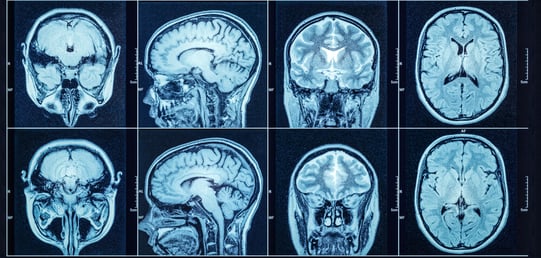
If you’ve followed your doctor’s advice about a gradual return to your normal activities after the concussion, and you’ve been cleared of any other conditions such as disc fracture or brain swelling, but you’re still experiencing worsening symptoms, you may be developing post-concussion syndrome (PCS).
This is what happened to Anthony Loubet, who was involved in a car accident in February 2019. After the accident, he went to the hospital, where a CT scan and an MRI scan failed to detect any damage to his brain. (Note that this result is unsurprising since these brain scans are not really designed to detect the type of changes in the brain caused by concussions.)
Anthony went home feeling dazed but thinking he got off lucky. However, things got worse over the next few days. He struggled with memory and focus, he fell asleep without warning in the middle of the day, his emotions varied wildly, and he experienced uncomfortable digestive issues.
In the months after the accident, Anthony followed the orders of the doctors and his therapists faithfully. He improved a little, but progress quickly plateaued, leaving him frustrated. He didn’t know it at the time, but Anthony had developed PCS. Once his chiropractor told him about Cognitive FX, Anthony came for an assessment. Getting the treatment he needed at our clinic meant he could finally go back to his job and hobbies again.
Like Anthony, many of our patients experience a variety of persistent symptoms of a concussion, including:
| Emotional | Cognitive | Physical |
|
|
|
|
|
|
|
|
|
|
|
|
|
|
|
|
|
|
|
|
|
|
|
|
|
|
|
|
||
|
||
|
||
|
||
|
||
|
||
|
||
|
||
|
||
|
||
|
In most cases, PCS symptoms are caused by a combination of one or more of the following:
To function normally, the brain needs a steady supply of energy and oxygen. Clusters of brain cells “request” the resources they need to perform a particular task, and surrounding blood vessels deliver at the right time and to the right place. This dynamic connection between the vascular system and the brain is called neurovascular coupling (NVC).
Concussions can uncouple this connection between brain cells and the surrounding blood vessels. Consequently, some areas of the brain receive too many or too few resources — and not always at the right time. When this mechanism fails, the brain will attempt to find an alternative pathway to complete a given task, but these alternate routes are always less efficient and will tire the brain more easily.
Dysfunctional NVC can cause symptoms such as headaches, fatigue, and irritability, regardless of which brain regions are affected. That said, PCS patients often experience symptoms specific to the areas affected by the concussion. For example, if the concussion affected areas of the brain involved with memories, patients may struggle forming or recalling short-term memories. If a part of the brain involved in balance is affected, patients might experience dizziness, balance problems, or difficulty maintaining an upright posture, for example.
Note: A previous concussion could mean you’re more at risk for lingering concussion symptoms this time around. Learn about the consequences of multiple concussions.
Concussions can also affect how the autonomic nervous system (ANS) communicates with the rest of the body.
The ANS regulates essential body functions, such as heart rate, blood pressure, body temperature, and breathing rate. Two subsections are important when discussing concussion symptoms: the sympathetic nervous system (SNS), which controls our “fight or flight” response, and the parasympathetic nervous system (PNS), which is responsible for our “rest and digest” process.
Under normal circumstances, the PNS and SNS dynamically trade control of key systems based on your activities. For example, the SNS might cause your heart rate and blood pressure to rise in response to a stressful situation. But when you take some deep breaths to relax, your PNS should kick in and help lower those numbers again. Each system makes thousands of little adjustments every day to maintain your body’s functions.
After a concussion, however, the SNS can become stuck in control, with the PNS unable to fully complete its role. This constant state of tension can lead to symptoms such as fatigue, headaches, high blood pressure, digestive issues, problems sleeping, neck pain, mood changes, and more.
Further reading: Autonomic nervous system dysfunction after a TBI
Due to their location in the brain, the pituitary gland and the hypothalamus are easily affected by a concussion. These two small structures regulate the production of multiple hormones, which can impact many different areas of the body.
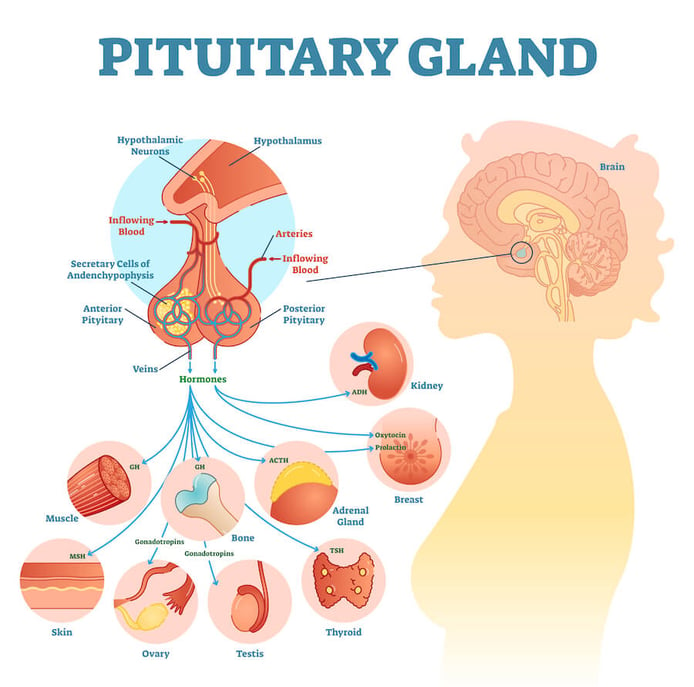
Inevitably, any hormone disruption caused by the concussion can cause a variety of symptoms, including:
Further reading:
After a concussion, many patients experience post-trauma vision syndrome, with symptoms such as blurred or double vision, sensitivity to light, vision loss, and eye pain. The underlying causes might include changes in focusing, eye teaming (how eyes work together), depth perception, eye tracking, and peripheral vision.
PCS may also cause vestibular problems. Head trauma can disrupt the communication between the vestibular system (located in the inner ears), the eyes, the body, and the brain, leading to dizziness, poor posture, instability when walking, fatigue, and difficulty performing routine daily activities.
Further reading:
If concussions disrupt the communication between the brain and the lungs, patients may suffer breathing problems, including shortness of breath, irregular breathing, dizziness, and fatigue.
Further reading: Can PCS cause breathing difficulties?
90% of our patients report reduced symptoms after their treatment at Cognitive FX. To see if you’re a good fit for our program, sign up for a consultation.

Once you’ve identified what’s aggravating your symptoms, it’s easier to determine next steps. Some options include the following:
Not every bump on the head requires emergency medical attention, but if you have any symptoms after a possible brain trauma, you should seek medical care. It’s especially important if you’ve noticed that symptoms are getting worse in the days after your injury.
Concussion symptoms can be hardly noticeable at first but worsen over time. Or, they might start strong and persist indefinitely. Sometimes, friends and family notice certain symptoms (such as unusual irritability or forgetfulness) before the patient does. Common symptoms that may get worse after a concussion include:
If these symptoms don’t improve or become worse during the days following a concussion, visit a doctor with experience treating head injuries. They can help you understand treatment options and rule out other possible causes of symptoms. Who you choose to see matters though. For example, a neurologist may only be able to prescribe medication, when what you really need is therapy. A sports medicine doctor could be an excellent choice — but only if well-versed in concussion treatment. Look for well-connected physicians who are familiar with treating concussions holistically.
It’s difficult to maintain the right balance of rest and exertion when you’re recovering from a concussion. You can’t jump right back into your normal life as if nothing has happened. The key to returning to daily activities safely is to pay attention to when symptoms start to worsen. Look for activities that provide enough physical and cognitive stimulation to promote healing but not enough to make symptoms severely worse. Some worsening of symptoms is OK. Finding the sweet spot between slight symptom increases and knowing when to stop is key to promoting recovery.
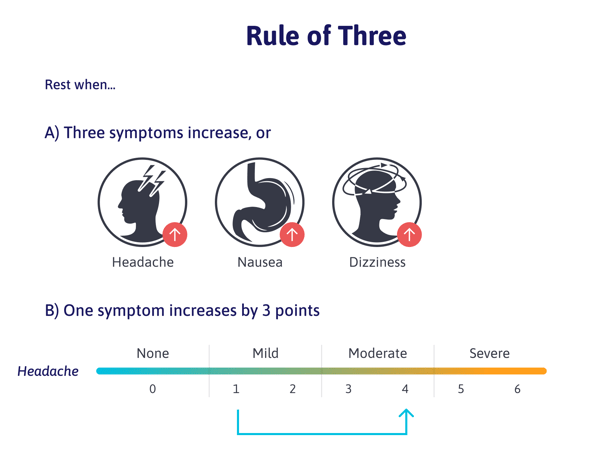
In practical terms, if you notice your symptoms getting significantly worse, then it’s time for a break. If you’re unsure when to take a break, you can follow the rule of three.
According to this rule, you need a break when:
You don’t need a break every time you experience a symptom. If you develop a mild headache but otherwise feel fine, then it’s usually safe to continue. In fact, this level of activity helps the brain heal faster and might reduce other symptoms in the future.
Other tips to avoid overexerting yourself include the following:
If your concussion happened a few weeks ago and you’re still experiencing symptoms, we recommend our sister clinic, Neural Effects, for treatment if you’re in Provo, Utah or anywhere in the Utah Valley area. Otherwise, you can use our guide to choosing a concussion clinic.
The best concussion recovery programs use a combination of exercise and cognitive therapies to help the brain return to healthy functioning. Active recovery can help reduce brain dysfunction and allow patients to return to normal activities sooner after the injury.
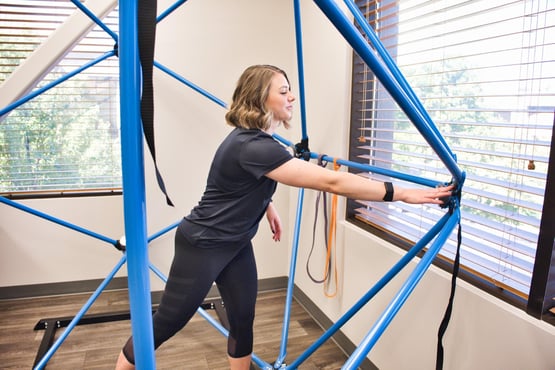
A therapist at Cognitive FX demonstrates a neurointegration exercise.
If you’re experiencing persistent post-concussion symptoms and it’s been over three months since your injury, you may need specialized treatment at Cognitive FX to address your post-concussion syndrome (PCS).
Our treatment — called Enhanced Performance in Cognition (EPIC) — combines physical exercise, multidisciplinary therapies, and lifestyle recommendations to restore normal brain function and alleviate symptoms.
At Cognitive FX, we don’t treat individual symptoms as disconnected problems. Instead, we address the underlying causes of the brain injury, including neurovascular coupling disruption, autonomic dysfunction, vision and vestibular issues, and breathing dysfunction.
Most patients don’t recover fully at the end of their treatment (one or two weeks) at Cognitive FX, but they experience significant improvements and continue to improve at home. It’s important to note that patients with long-term symptoms caused by a severe traumatic brain injury may experience more modest gains than those who had a mild traumatic brain injury.
In addition, our treatment program is available for treating most types of brain injuries, including transient ischemic attack, chemo-induced brain fog, long COVID, carbon monoxide (CO) poisoning, untreated whiplash, and more.
For example, our patient Nate Benson experienced prolonged exposure to CO as a child. This exposure caused persistent symptoms, including brain fog, difficulty concentrating, and headaches. Several years later, Nate found Cognitive FX. By the end of treatment, he noticed significant improvements.
“When I left the clinic, I was happy! I felt motivated. A lot of that was thanks to the therapists encouraging me. I did feel sharper. I felt way quicker. My reaction time and my ability to process things was faster,” he recalled. “My sister would be driving me home, and there'd be a yellow light at the intersection. My foot would jerk to brake about half a second before she would,” he laughed. “So my reaction time improved quite a bit.”
90% of our patients report reduced symptoms after their treatment at Cognitive FX. To see if you’re a good fit for our program, sign up for a consultation.
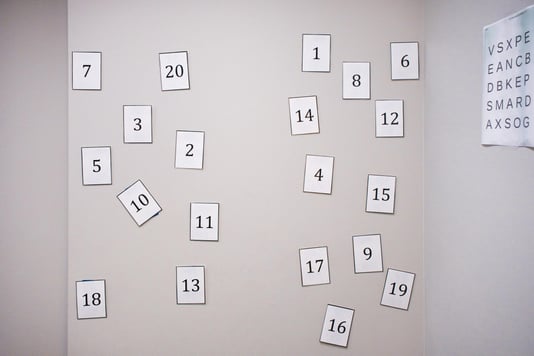
Before treatment begins, every patient completes a detailed exam. This includes a medical history review, symptom questionnaires, physical exams, cognitive exams, emotional evaluation, and several brain scans.
We use standard MRI to check for any structural issues patients may be experiencing, plus a functional MRI (fMRI) to assess blood flow dynamics throughout the brain. The functional Neurocognitive Imaging (fNCI) scan assesses neurovascular coupling and communication health in 100 different brain regions.
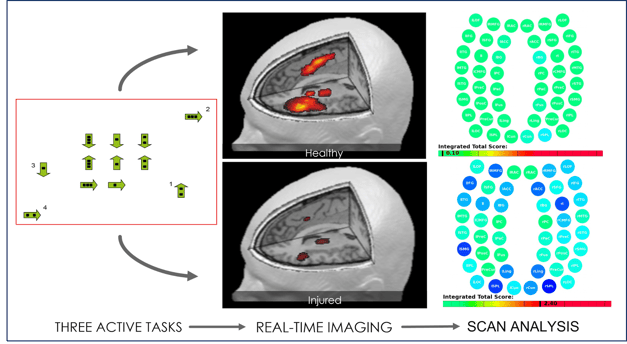
This state-of-the-art scan is a key part of our treatment, and we are the only clinic in the U.S. to offer this service. Crucially, the scan can identify exactly what areas of the brain were affected by the concussion, allowing our therapists to devise a treatment plan specifically tailored for each patient. While the list of therapies offered is similar, the specific exercises done in each session and how they’re combined are unique for each patient. This is why our patient recovery stories, like that of Sam Pembleton, are so consistent.
Sam experienced a concussion while playing soccer. She tried resting after her injury, but it made things worse. She struggled with cognitive symptoms and schoolwork, which often triggered headaches and fatigue.
Finally, after five years of searching for a cure, she found Cognitive FX. The treatment she received targeted exactly what she needed. The cognitive therapy sessions stood out to her the most.
“It was an hour-long therapy, and it was just one-on-one with someone. You’d do a cognitive activity, like sorting through a deck of cards, but at the same time, someone would give you a four-letter sentence, and you'd have to arrange the words alphabetically while you were still sorting through the cards,” she recalled. “It was a lot of multitasking!”
![EPIC Treatment memory game with cards [V1]](https://www.cognitivefxusa.com/hs-fs/hubfs/EPIC%20Treatment%20memory%20game%20with%20cards%20%5BV1%5D.jpg?width=635&height=448&name=EPIC%20Treatment%20memory%20game%20with%20cards%20%5BV1%5D.jpg)
This tailored approach was life-changing for Sam.
“I think the most difficult thing for people to grasp is the fact that unlike a broken bone, a concussion is so different for everyone. Each person’s brain is so different that one treatment may work for one person, whereas someone else may need a completely different approach,” she said. “A concussion is like a fingerprint. It's unique for each person.”
Treatment at Cognitive FX is effective not only because we’re able to tailor therapy to each patient’s scan results, but also because we combine cardiovascular exercise with therapy. All of our patients go through a repeating, three-step cycle: Prepare, Activate, and Recover.
The prepare phase of the treatment starts with short sessions of aerobic exercises, typically done on a stationary bike, elliptical, or treadmill. The aim is to promote healthier blood flow in the brain and trigger the release of crucial neurochemicals in the brain, including one called brain-derived neurotrophic factor (BDNF). BNDF helps the brain respond better to changes and enhances the impact of subsequent therapies.
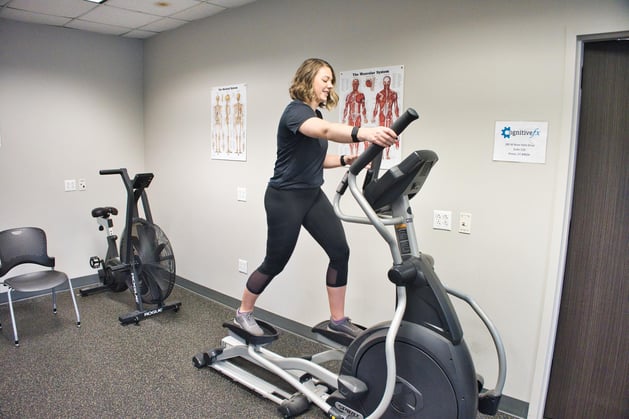
During the activate step, patients engage in a series of therapies to treat physical and cognitive symptoms. Therapies include:
Throughout the day, patients also have periods of rest to recover and get ready for the next set of therapies. These periods include breathing exercises to promote relaxation, neuromuscular massage of the neck and shoulders, and mindfulness exercises.
At the end of the treatment, patients rate their symptoms again and undergo a second scan to assess how their brains are recovering. They also meet with our therapists to discuss progress and receive exercises to complete at home to continue their recovery. These typically include aerobic exercises, cognitive activities, and relaxation techniques. We recommend that patients spend about an hour per day, five days a week on these exercises at first, but they can slowly reduce the time spent as they recover.
If our team feels patients would benefit from further assistance, we can make appropriate recommendations for follow-up visits with other specialists.

It’s important to note that treatment isn’t always fun and games. For example, Sam Pembleton (mentioned above) experienced migraines every single night after treatment, and she didn’t feel like she was improving much at first. But her end-of-week scans showed significant improvement in her brain function.
“Seeing how much I had improved in every single section gave me hope and pushed me to keep doing my exercises at home,” she said. Once she returned home, she did her ‘homework’ faithfully, and three months after her treatment date, her headaches disappeared completely.
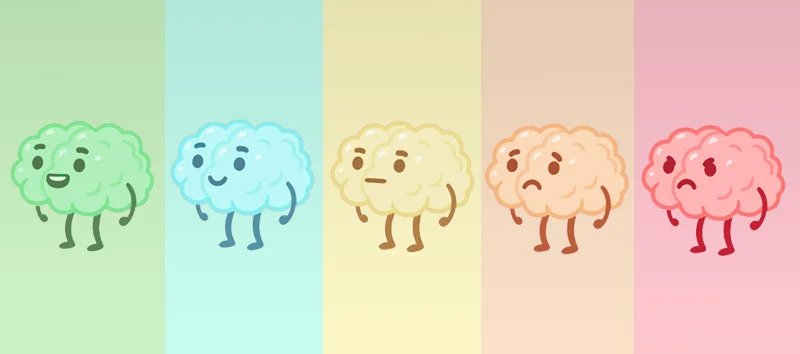
We’ve covered many concussion and PCS symptoms in detail in other articles. See below for a few examples of symptoms and related recovery recommendations:
On average, our patients’ symptoms improve by 60% after just one week of treatment at our center specializing in the long-term symptoms of head injury. To see if you are eligible for treatment, sign up for a consultation.

Dr. Mark D. Allen holds a Ph.D. in Cognitive Science from Johns Hopkins University and received post-doctoral training in Cognitive Neuroscience and Functional Neuroimaging at the University of Washington. As a co-founder of Cognitive Fx, he played a pivotal role in establishing the unique and exceptional treatment approach. Dr. Allen is renowned for his pioneering work in adapting fMRI for clinical use. His contributions encompass neuroimaging biomarkers development for post-concussion diagnosis and innovative research into the pathophysiology of chronic post-concussion symptoms. He's conducted over 10,000 individualized fMRI patient assessments and crafted a high-intensity interval training program for neuronal and cerebrovascular recovery. Dr. Allen has also co-engineered a machine learning-based neuroanatomical discovery tool and advanced fMRI analysis techniques, ensuring more reliable analysis for concussion patients.
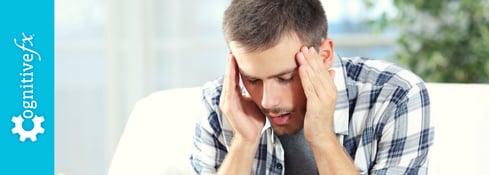
Concussions can have long-term physical, cognitive, and emotional effects. Symptoms such as brain fog, headaches, and depression can last for months or years after the initial injury. When the...

If you’ve started getting headaches after you’ve suffered whiplash, you’re not alone. After neck pain, headaches are the second most common symptom from whiplash. Over 60 percent of patients have...

Post-concussion syndrome is downright frustrating to experience. Doctors often miss it during diagnosis, and even if they do make the diagnosis, treatment methods vary considerably from clinic to...

Loss of taste and smell featured heavily in the news during the COVID-19 pandemic as one of the first signs of infection. But this is not the only condition that may lead to loss of smell. You could...
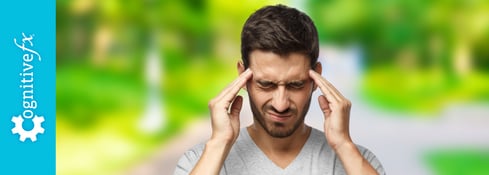
Headaches are one of the most common symptoms after a head injury (studies show70%of mTBI patients experience them, though 84% of our patients report having them). They can develop after mild,...
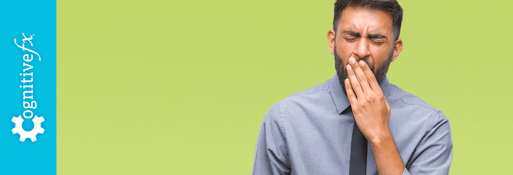
It’s not uncommon for people in today’s society to be tired. The demands on our time seem to be never ending. However, there’s a difference between being tired from being on the go all of the time...
Published peer-reviewed research shows that Cognitive FX treatment leads to meaningful symptom reduction in post-concussion symptoms for 77% of study participants. Cognitive FX is the only PCS clinic with third-party validated treatment outcomes.
READ FULL STUDY